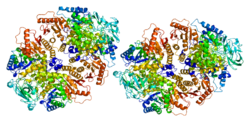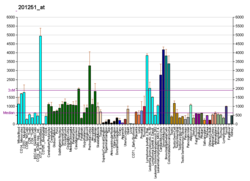Bi-functional role within tumors
PKM2 is expressed in most human tumors. [11] [14] [15] Initially, a switch from PKM1 to PKM2 expression during tumorigenesis was discussed. [37] These conclusions, however, were the result of misinterpretation of western blots that had used PKM1-expressing mouse muscle as the sole non-cancer tissue. In clinical cancer samples, solely an up-regulation of PKM2, but no cancer specificity, could be confirmed. [38]
In contrast to the closely homologous PKM1, which always occurs in a highly active tetrameric form and which is not allosterically regulated, PKM2 may occur in a tetrameric form but also in a dimeric form. The tetrameric form of PKM2 has a high affinity to its substrate phosphoenolpyruvate (PEP), and is highly active at physiological PEP concentrations. When PKM2 is mainly in the highly active tetrameric form, which is the case in differentiated tissues and most normal proliferating cells, glucose is converted to pyruvate under the production of energy. Meanwhile, the dimeric form of PKM2 is characterized by a low affinity to its substrate PEP and is nearly inactive at physiological PEP concentrations. Dimeric PKM2 produces little to no ATP in the conversion of PEP to pyruvate, making the net yield of ATP zero for glycolysis. [39] When PKM2 is mainly in the less active dimeric form, which is the case in tumor cells, all glycolytic intermediates above pyruvate kinase accumulate and are channelled into synthetic processes, which branch off from glycolytic intermediates such as nucleic acid-, phospholipid-, and amino acid synthesis. [23] [24] [25] Nucleic acids, phospholipids, and amino acids are important cell building-blocks, which are greatly needed by highly proliferating cells, such as tumor cells.
Due to the key position of pyruvate kinase within glycolysis, the tetramer:dimer ratio of PKM2 determines whether glucose carbons are converted to pyruvate and lactate under the production of energy (tetrameric form) or channelled into synthetic processes (dimeric form). [23] [24] [25] However, even if PKM2 activity is low leading to the diversion of upstream intermediates to synthetic processes, pyruvate and lactate will still be made using carbon atoms from glucose and other metabolites through 86 pathways bypassing pyruvate kinase. [40] These pyruvate kinase bypassing pathways are different from those participating in gluconeogenesis. Interestingly, many of the pyruvate kinase bypassing pathways use metabolites that transit through mitochondria, highlighting the importance of mitochondria in cancer metabolism irrespective of oxidative phosphorylation.
In tumor cells, PKM2 is mainly in the dimeric form and has, therefore, been termed Tumor M2-PK. The quantification of Tumor M2-PK in plasma and stool is a tool for early detection of tumors and follow-up studies during therapy. The dimerization of PKM2 in tumor cells is induced by direct interaction of PKM2 with different oncoproteins (pp60v-src, HPV-16 E7, and A-Raf). [31] [32] [41] [42] [43] The physiological function of the interaction between PKM2 and HERC1 as well as between PKM2 and PKCdelta is unknown). [44] [45] Due to the essential role of PKM2 in aerobic glycolysis (The Warburg effect) which is a dominant metabolic pathway used by cancer cells. [26] Its overcome in this pathway in macrophages may lead to better outcome in experimental sepsis. [46] [47] [48] Thus, PKM2 is a regulator of LPS- and tumor-induced PD-L1 expression on macrophages and dendritic cells as well as tumor cells. [26]
Studies involving the use of PKM2 activators have looked at promoting the conversion of dimeric PKM2 to its tetrameric form, hindering the growth of cancer cells. [49] Furthermore, concurrent research is centered on targeting the tetrameric form of PKM2 with small-molecule activators, such as TEPP-46 and DASA-58, to increase its resistance to inhibition. [50]
However, the tetramer:dimer ratio of PKM2 is not stationary value. High levels of the glycolytic intermediate fructose 1,6-bisphosphate induce the re-association of the dimeric form of PKM2 to the tetrameric form. As a consequence, glucose is converted to pyruvate and lactate with the production of energy until fructose 1,6-bisphosphate levels drop below a critical value to allow dissociation to the dimeric form. This regulation is termed metabolic budget system. [24] [25] [51] Another activator of PKM2 is the amino acid serine. [24] The thyroid hormone 3,3´,5-triiodi-L-thyronine (T3) binds to the monomeric form of PKM2 and prevents its association to the tetrameric form. [52]
In tumor cells, the increased rate of lactate production in the presence of oxygen is termed the Warburg effect. Genetic manipulation of cancer cells so that they produce adult PKM1 instead of PKM2 reverses the Warburg effect and reduces the growth rate of these modified cancer cells. [37] Accordingly, cotransfection of NIH 3T3 cells with gag-A-Raf and a kinase dead mutant of PKM2 reduced colony whereas cotransfection with gag-A-Raf and wild type PKM2 led to a doubling of focus formation. [53]
The dimeric form of PKM2 has been observed to have protein kinase activity in tumor cells. It is able to bind to and phosphorylate the histone H3 of chromatin in cancer cells, thereby having a role in the regulation of gene expression. [54] This modification of histone H3 and the resulting involvement in gene expression regulation can be a cause of tumor cell proliferation. [54]
The pyruvate kinase activity of PKM2 can be promoted by SAICAR (succinylaminoimidazolecarboxamide ribose-5′-phosphate), an intermediate in purine biosynthesis. In cancer cells, glucose starvation leads to a rise in SAICAR levels and the subsequent stimulation of pyruvate kinase activity of PKM2. This allows for the completion of the glycolytic pathway to produce pyruvate and, therefore, survival under glucose deprivation. [55] In addition, an abundance of SAICAR can modify glucose absorption and lactate production in cancer cells. [55] However, it has been shown that SAICAR binding also sufficiently stimulates the protein kinase activity of PKM2 in tumor cells. [56] In turn, the SAICAR-PKM2 complex can potentially phosphorylate a number of other protein kinases using PEP as the phosphate donor. Many of these proteins contribute to the regulation of cancer cell proliferation. Specifically, PKM2 can be a component in mitogen-activated protein kinase (MAPK) signaling, which is associated with increased cell proliferation if functioning improperly. This provides a potential link between SAICAR-activated PKM2 and cancer cell growth. [56]
Natural mutations and carcinogenesis
Two missense mutations, H391Y and K422R, of PKM2 were found in cells from Bloom syndrome patients prone to developing cancer. Results show that, despite the presence of mutations in the inter-subunit contact domain, the K422R and H391Y mutant proteins maintained their homotetrameric structure, similar to the wild-type protein, but showed a loss of activity of 75 and 20%, respectively. H391Y showed a 6-fold increase in affinity for its substrate phosphoenolpyruvate and behaved like a non-allosteric protein with compromised cooperative binding. However, the affinity for phosphoenolpyruvate was lost significantly in K422R. Unlike K422R, H391Y showed enhanced thermal stability, stability over a range of pH values, a lesser effect of the allosteric inhibitor Phe, and resistance toward structural alteration upon binding of the activator (fructose 1,6-bisphosphate) and inhibitor (Phe). Both mutants showed a slight shift in the pH optimum from 7.4 to 7.0. [57] The co-expression of homotetrameric wild type and mutant PKM2 in the cellular milieu resulting in the interaction between the two at the monomer level was substantiated further by in vitro experiments. The cross-monomer interaction significantly altered the oligomeric state of PKM2 by favoring dimerisation and heterotetramerization. In silico study provided an added support in showing that hetero-oligomerization was energetically favorable. The hetero-oligomeric populations of PKM2 showed altered activity and affinity, and their expression resulted in an increased growth rate of Escherichia coli as well as mammalian cells, along with an increased rate of polyploidy. These features are known to be essential to tumor progression. [58]
Further, cells stably expressing exogenous wild- or mutant-PKM2 (K422R or H391Y) or co-expressing both wild and mutant (PKM2-K422R or PKM2-H391Y), were assessed for cancer metabolism and tumorigenic potential. Cells co-expressing PKM2 and mutant (K422R or H391Y) showed significantly aggressive cancer metabolism, compared to cells expressing either wild or mutant PKM2 independently. A similar trend was observed for oxidative endurance, tumorigenic potential, cellular proliferation and tumor growth. These observations signify the dominant negative nature of these mutations. Remarkably, PKM2-H391Y co-expressed cells showed a maximal effect on all the studied parameters. Such a dominant negative impaired function of PKM2 in tumor development is not known; also evidencing for the first time the possible predisposition of BS patients with impaired PKM2 activity to cancer, and the importance of studying genetic variations in PKM2 in future to understand their relevance in cancer in general. [59]
















